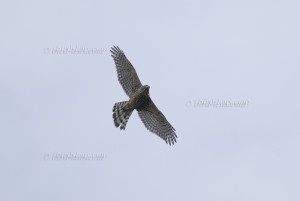 When scanning images of the portfolio of bird-lens.com it was noticed that the Northern Goshawk is still significantly under-represented . Therefore locations were actively scanned which are known to be frequented regularly by Goshawks. For this purpose sites near wetlands were visited especially in late summer or fall, where many (larger) birds rest and / or moult and are therefore available as prey for inexperienced, young Goshawks. Here, I could see and even photograph a young female Goshawk (Accipiter gentilis) approaching me within a few dozen meters. As a result you can see some pictures of this wonderful Northern Goshawk in flight. So strong and breast -heavy like the bird on the pictures in the gallery, the female Goshawk can be differentiated easily from the Sparrowhawk (Accipiter nisus) by size alone.
When scanning images of the portfolio of bird-lens.com it was noticed that the Northern Goshawk is still significantly under-represented . Therefore locations were actively scanned which are known to be frequented regularly by Goshawks. For this purpose sites near wetlands were visited especially in late summer or fall, where many (larger) birds rest and / or moult and are therefore available as prey for inexperienced, young Goshawks. Here, I could see and even photograph a young female Goshawk (Accipiter gentilis) approaching me within a few dozen meters. As a result you can see some pictures of this wonderful Northern Goshawk in flight. So strong and breast -heavy like the bird on the pictures in the gallery, the female Goshawk can be differentiated easily from the Sparrowhawk (Accipiter nisus) by size alone.
Other images were shot from an elevated vantage point in the forest. You need time and patience. But then you see pretty easy that Northern Goshawk breeding pairs are territorial. It was also shown that the nests are evenly distributed in the suitable breeding area. Breeding birds defend the environment of their nest within a certain radius, which should not exceed 1km.
Outside the breeding season, territorial behavior is observed, too. Other raptors as the Common Buzzards (Buteo buteo) shown on the images are vehemently attacked. Especially adult males show a year-round commitment to the nest area and defend their territory. On the other hand young female Goshawks, independently roaming in others territory as shown in the picture apparently penetrate easily into foreign territories.
The Northern Goshawk is about 45 to 67 cm in length and has a wingspan of about 130 cm. The female is larger than the male. The adult plumage is brownish gray on the back and consists of a white chest which is finely barred black. Young birds are brownish until the first moult on the upper side. The barring on the breast is replaced in young birds by a streaking or a line drawing. The stripes can be found on a white to beige-brown or in young birds on a yellowish ground. The iris of the eye is bright yellow in young birds. The color shimmers with age more and more into reddish. The beak is black with a yellow shoulder (cere).
The plumage is very similar in both sexes. Adult males are something darker and more blue-gray on the upper side than adult females and show a slightly higher contrasted head pattern.
Small Northern Goshawk males can be easily confused with larger females Sparrowhawk in flight. But, the Northern Goshawk is – in comparison to a female Sparrowhawk – a bird of prey with a stronger body and longer, broader wings. He is to be distinguished from the similar Sparrowhawk by a tail with more rounded tail corners. The wings of the Goshawk (Accipiter gentilis ) are relatively short, with rounded ends, the tail is proportionately not as long as the tail of a Sparrowhawk (Accipiter nisus) and is significantly more spread during soaring flights. The flight pattern in general is quite similar to that of the smaller Accipiter. One should pay attention to three characteristics:
Northern Goshawks have a much longer neck and the head give a (three-)squared and striking impression. In addition, Northern Goshawks beat slower and more powerful with the wings. Due to the observation distances you should pay attention in flight to the overall impression. The Northern Goshawk has slow, deliberate, deep and expansive acting, quite elastic wing beats. The wings are thereby beaten uniformly both above and below the horizontal line. The number of wing beats in the gliding phase is higher and the gliding phase is shorter than what the Sparrowhawk show.
The best time to look for Northern Goshawks in addition to the late summer or autumn for young Goshawks is on mild days in late winter and early spring. Then the Goshawks are in their mating rituals – the display flights. Basically, flying Goshawks can be observed at all times of the year, the most reliable in good weather.
To cope with the growing demand for top shots of the rarer bird species of the Palearctic, Bird-Lens is keen to enrich the range of pictures of birds you can find in the western palearctic area. The nice images you find in that blog and in the corresponding gallery are only a first impression, what you find in the gallery in the “Pictures Shop”. Just give me a message, if I could serve you with additional images.
Other successful shootings you can see under: www.bird-lens.com.